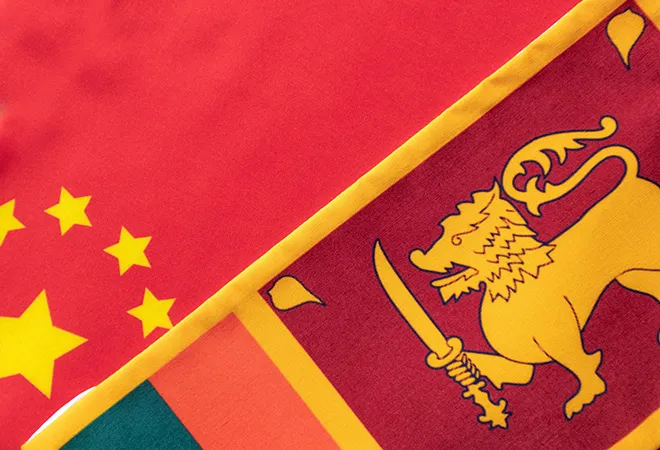
This is the 130th article in the series – The China Chronicles.
Ever since Sri Lanka plunged into a full-fledged economic crisis, China—the island state’s largest bilateral creditor and trade partner—has provided it with humanitarian assistance of a mere US$74 million. China is also yet to decide on Sri Lanka’s request for loan restructuring and additional financial aid worth US$4 billion.
Former Sri Lankan President Gotabaya Rajapaksa has reasoned this passivity by stating that China is vitalising its interests in Southeast Asia and Africa over South Asia. This narrative, however, isn’t convincing, as China continues to have large stakes and investments in the region. Retreating from South Asia is also difficult for Beijing, as the Indian and Pacific Oceans emerge as the epicentre of power contestation in the new world order.
It appears that China is cautiously recalculating its South Asian policy to further its interests. China’s South Asian strategy is shaped by two intertwined tactics—elite capture and extensive lending. In recent years, both of these tactics have come under severe stress given India’s attempts to win back the region, domestic compulsions and national interests of South Asian states, and the COVID-19 pandemic. The Sri Lankan crisis has thus only served as a final wake-up call for China to recalibrate its South Asian policy.
The elite capture and the blowback
China’s deep inroads in South Asia began in Sri Lanka in the early 2000s, even before the Belt and Road Initiative (BRI) was introduced. The Rajapaksa government—elected in 2005, adopted ruthless violence to end the civil war and proposed grand plans for the post-war economic recovery. China used this opportunity to develop personal relationships with the Rajapaksas by selling them arms, providing much-needed investments, aid and infrastructure projects, and protecting them from accusations of human rights violations. This opportunism gave China significant leverage within the elites of the Sri Lankan polity.
China’s South Asian strategy is shaped by two intertwined tactics—elite capture and extensive lending.
This bonhomie helped China influence, bribe, and exploit the Sri Lankan bureaucracy, media, and political elites, directly and indirectly. Chinese firms also funded their favourable candidates in elections. This mechanism reaped financial incentives for the Sri Lankan elites and also helped China expedite several white elephant projects and further its interests. With this calculation, China expected the Rajapaksas to remain sensitive to Chinese demands and interests.
The elite capture also came at a cost for India and other major powers—such as the US and Japan. The elites deterred influence and significant projects from other competitors at China’s behest. On multiple instances, Chinese submarines started visiting Sri Lankan harbours, and China was also offered projects and an aircraft repair base—precariously close to India. Throughout these years, the Rajapaksas continued to show sensitivities to China. In early 2021, the Sri Lankan government cancelled India and Japan’s East Container Terminal project, offered a few energy projects to China in the Jaffna peninsula, and even passed the Colombo Port Economic Commercial bill that allowed foreigners to take part in the government.
But as the economic crisis in Sri Lanka furthered, domestic compulsions mandated the Rajapaksas to exercise some autonomy and balancing—much to China’s annoyance. By late 2021, Sri Lanka began to show sensitivity to India to attract some financial benefits. The cancelling of Chinese energy projects in the Jaffna peninsula exacerbated the differences between Sri Lankan and China that had already surfaced due to disagreement over a fertiliser deal.
Sri Lanka’s defaulting on loans and seeking International Monetary Fund (IMF) assistance further upset China. Sri Lanka currently owes 10 percent of its overall debt and 20 percent of its debt stock to China—the highest amongst its bilateral lenders. In other words, Chinese loans have been maturing in recent years and occupying a large sum and proportion of Sri Lanka’s repayment scheme. Reasonably, China has also opposed forgoing an amount of debt as suggested by the IMF. The island nation’s default and approaching the IMF thus came at a vast cost to Chinese influence and interests.
As China cultivated close relations with the Rajapaksa clan and invested in them for nearly two decades, it would have expected favourable policies and unquestioned loyalty. But domestic compulsions and national interests compelled the island state to exercise its agency. In addition, the subsequent ousting of pro-Chinese leaders, such as President Abdulla Yameen in the Maldives in 2018 and Prime Minister KP Oli in Nepal in 2021 had also put China’s elite capture tactic under severe strain. The Rajapaksas’ balancing and autonomous decision-making have thus come as a final blow to China. Therefore, persuading the former to adopt a passive stance and recalibrate its regional approach before furthering its interests.
Extensive lending
The elite capture also went hand-in-hand with China’s increased investments and financial assistance. Sri Lanka became a flagship country of China’s engagement with South Asia with an investment of US$12.1 billion between 2006-2019. This was equivalent to 14 percent of Sri Lanka’s GDP in 2018. These investments were often accompanied by financial assistance and high-interest loans too. In total, China alone provided up to 10 percent of Sri Lanka’s total debts, i.e., nearly US$5.1 billion.
China also helped Sri Lanka to mitigate the economic implications of the COVID pandemic. It provided economic assistance of US$600 million in 2020 and US$2 billion in 2021—out of which a currency swap of US$1.5 billion was subjected to use if only Sri Lanka maintained a minimum foreign reserve worth three months of imports.
As China cultivated close relations with the Rajapaksa clan and invested in them for nearly two decades, it would have expected favourable policies and unquestioned loyalty. But domestic compulsions and national interests compelled the island state to exercise its agency.
However, as the economic crisis deepened in Sri Lanka in late 2021 and 2022, China’s response became more lukewarm. It has continued to delay its decisions on the Sri Lankan government’s requests to ease conditions on currency swap, provide additional loans and credit lines worth US$2.5 billion, and loan restructuring. This proactive response in 2020 and early 2021 and the subsequent passive response have largely depended on how the Rajapaksas accommodated Chinese interests and sensitivities. As the differences with the Rajapaksas sharpened, China’s passivity brewed.
This passivity is also in part triggered by the economic devastations caused by COVID-19. In addition to Sri Lanka, China has significantly invested and lent assistance to other South Asian countries. In 2018, Chinese investments in other South Asian countries equated to 16 percent of Pakistan’s GDP, 15 percent of Maldives' GDP, and 8 percent of Bangladesh’s GDP. However, COVID-19 has taken a toll on the economy of the developing world including China. In this regard, China does not want to set a precedent for countries to bail out on BRI projects or request new loans and loan restructuring. This hesitancy dominates the Chinese foreign policymaking as South Asian countries, such as Nepal, Pakistan, and Bangladesh are going through economic difficulties, and Bangladesh and Pakistan are even betting on the IMF for economic bailouts.
China’s passivity to the crisis is thus related to the limitations of its elite capturing and extensive lending tactics across South Asia, specifically in Sri Lanka. This does not mean Beijing will sit idle for long—the stakes are too high for any such inactivity. In fact, China continues to have close relations with various stakeholders in Sri Lanka and has also persuaded them in the past to abide by Chinese interests and sensitivities. Beijing will, however, wait to reassert itself and further its interests in the region with a recalibrated approach and renewed networks of elite capture. The glimpses of this recalibration is perhaps getting less blurred as the Chinese vessel–Yuan Wang 5–is set to dock in Sri Lanka in the coming weeks.
The views expressed above belong to the author(s). ORF research and analyses now available on Telegram! Click here to access our curated content — blogs, longforms and interviews.




 PREV
PREV


